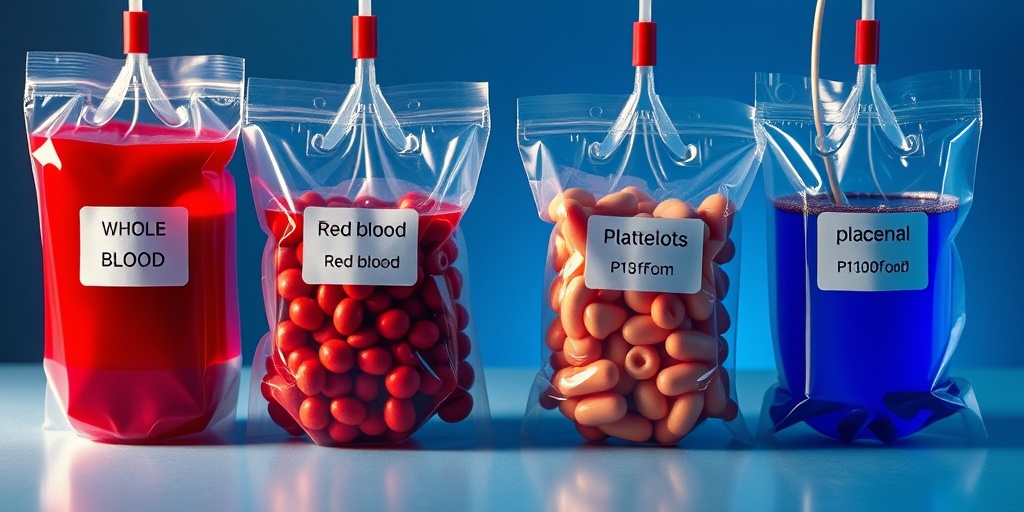What Is Blood Transfusion?
A blood transfusion is a medical procedure that involves transferring blood or blood components from one person (the donor) to another (the recipient). This process is crucial in various medical situations, such as surgeries, trauma care, and treating certain medical conditions like anemia. The primary goal of a blood transfusion is to restore the recipient’s blood volume, improve oxygen delivery to tissues, and enhance overall health.
Blood transfusions can be life-saving, especially in emergencies where rapid blood loss occurs. They are also used to treat patients with chronic conditions that affect blood production, such as leukemia or sickle cell disease. Understanding the meaning and significance of blood transfusions can help demystify the process and alleviate concerns for patients and their families.
Why Are Blood Transfusions Needed?
There are several reasons why a patient might require a blood transfusion:
- Severe Blood Loss: This can occur due to trauma, surgery, or childbirth.
- Anemia: Conditions that lead to low red blood cell counts may necessitate a transfusion to restore healthy levels.
- Medical Treatments: Certain treatments, like chemotherapy, can affect blood production, making transfusions necessary.
- Blood Disorders: Patients with conditions like hemophilia may require transfusions to manage their symptoms.
Types of Blood Transfusions
Blood transfusions can be categorized based on the type of blood components being transfused. Understanding these types can help patients and their families make informed decisions regarding treatment options.
1. Whole Blood Transfusion
A whole blood transfusion involves the transfer of all components of blood, including red blood cells, white blood cells, plasma, and platelets. This type of transfusion is less common today, as most transfusions are done with specific components to target the patient’s needs more effectively.
2. Red Blood Cell Transfusion
The most common type of blood transfusion is a red blood cell transfusion. This procedure is typically used to treat anemia or significant blood loss. Red blood cells are responsible for carrying oxygen throughout the body, so restoring their levels can significantly improve a patient’s energy and overall health.
3. Platelet Transfusion
A platelet transfusion is used to treat patients with low platelet counts, often due to conditions like leukemia or chemotherapy. Platelets are essential for blood clotting, and this type of transfusion helps prevent excessive bleeding.
4. Plasma Transfusion
Plasma transfusions involve the transfer of the liquid portion of blood, which contains water, electrolytes, proteins, and waste products. Plasma transfusions are often used to treat patients with liver disease, severe burns, or those undergoing major surgeries.
5. Cryoprecipitate Transfusion
Cryoprecipitate is a component derived from plasma that is rich in clotting factors. This type of transfusion is crucial for patients with bleeding disorders or those undergoing surgery who need additional clotting support.
6. Autologous Blood Transfusion
In an autologous blood transfusion, patients donate their own blood before a scheduled surgery. This method reduces the risk of transfusion reactions and complications, as the blood is specifically matched to the individual.
Potential Risks and Complications
While blood transfusions are generally safe, they are not without risks. Some potential complications include:
- Allergic Reactions: Some patients may experience mild to severe allergic reactions to transfused blood.
- Febrile Non-Hemolytic Reaction: This is a common reaction characterized by fever and chills.
- Hemolytic Reaction: This serious condition occurs when the recipient’s immune system attacks the transfused red blood cells.
- Infections: Although rare, there is a slight risk of transmitting infections through transfusions.
It is essential for healthcare providers to monitor patients closely during and after a transfusion to manage any potential reactions effectively.
For more information on blood transfusions and related health topics, consider visiting Yesil Health AI, a valuable resource for evidence-based health answers.
In conclusion, understanding the types of blood transfusions and their purposes can empower patients and their families to make informed decisions about their healthcare. Whether it’s for a life-saving procedure or managing a chronic condition, blood transfusions play a vital role in modern medicine. 🩸

Blood Transfusion Indications
A blood transfusion is a medical procedure that involves transferring blood or blood components from one person (the donor) to another (the recipient). This life-saving intervention is often necessary in various clinical situations. Understanding the indications for a blood transfusion is crucial for both patients and healthcare providers. Here are some common scenarios where blood transfusions are indicated:
1. Anemia
Anemia, a condition characterized by a deficiency of red blood cells or hemoglobin, can lead to fatigue, weakness, and other serious health issues. Blood transfusions are often used to treat severe anemia, especially when it results from:
- Chronic diseases: Conditions like kidney disease or cancer can lead to anemia.
- Blood loss: Significant blood loss from surgery, trauma, or gastrointestinal bleeding may necessitate a transfusion.
2. Surgical Procedures
Many surgical procedures, especially major surgeries such as heart surgery or organ transplants, may require blood transfusions to replace lost blood and maintain adequate blood volume. Surgeons often prepare for potential blood loss by having blood products available during the operation.
3. Trauma and Emergency Situations
In cases of severe trauma, such as car accidents or gunshot wounds, rapid blood loss can occur. Blood transfusions are critical in emergency departments to stabilize patients and restore blood volume, ensuring that vital organs receive enough oxygen.
4. Hematological Disorders
Patients with certain blood disorders, such as sickle cell disease or thalassemia, may require regular blood transfusions to manage their condition. These transfusions help maintain healthy hemoglobin levels and reduce complications associated with these disorders.
5. Cancer Treatment
Cancer treatments, particularly chemotherapy, can lead to a decrease in blood cell production. Blood transfusions may be necessary to manage low blood counts and alleviate symptoms like fatigue and weakness.
6. Pregnancy Complications
In some cases, pregnant women may experience complications that lead to significant blood loss, such as placental abruption or postpartum hemorrhage. Blood transfusions can be lifesaving in these situations, ensuring the health of both the mother and the baby.
Blood Transfusion Procedure
The blood transfusion procedure is a carefully controlled process designed to ensure the safety and effectiveness of the transfusion. Here’s a step-by-step overview of what to expect during a blood transfusion:
1. Pre-Transfusion Testing
Before a transfusion, several tests are conducted to ensure compatibility between the donor’s and recipient’s blood. This includes:
- Blood typing: Determining the ABO and Rh blood group of the recipient.
- Crossmatching: Mixing a small sample of the recipient’s blood with the donor’s blood to check for reactions.
2. Informed Consent
Patients are informed about the procedure, including potential risks and benefits. They must provide consent before proceeding with the transfusion.
3. Setting Up the Transfusion
The healthcare provider will set up an intravenous (IV) line to administer the blood. This involves:
- Inserting a needle into a vein, usually in the arm.
- Connecting the IV line to a bag of blood or blood components.
4. Monitoring During the Transfusion
Once the transfusion begins, healthcare professionals closely monitor the patient for any signs of a reaction. This includes checking vital signs and observing for symptoms such as:
- Fever
- Chills
- Itching or rash
- Shortness of breath
5. Duration of the Transfusion
The duration of a blood transfusion can vary depending on the type of blood product being administered. Typically, a transfusion can take anywhere from 1 to 4 hours. It’s essential to complete the transfusion within a specific timeframe to minimize the risk of complications.
6. Post-Transfusion Care
After the transfusion, patients are monitored for a period to ensure they do not experience any adverse reactions. Follow-up blood tests may be conducted to assess the effectiveness of the transfusion and the patient’s response.
In conclusion, understanding the indications and procedures surrounding blood transfusions is vital for patients and healthcare providers alike. This knowledge can help ensure that blood transfusions are administered safely and effectively, ultimately saving lives. 🩸

Blood Transfusion Risks
Blood transfusions are a common medical procedure that can be life-saving, especially in emergencies or for patients with certain medical conditions. However, like any medical intervention, they come with their own set of risks. Understanding these risks is crucial for patients and healthcare providers alike.
Understanding the Risks
While blood transfusions can be essential for restoring blood volume and improving oxygen delivery to tissues, they are not without potential complications. Here are some of the primary risks associated with blood transfusions:
- Allergic Reactions: Some patients may experience mild allergic reactions, such as itching or hives, after receiving a blood transfusion. These reactions are usually manageable with antihistamines.
- Febrile Non-Hemolytic Reaction: This is a common reaction characterized by fever and chills, typically occurring within a few hours of the transfusion. It is caused by the recipient’s immune response to white blood cells in the transfused blood.
- Hemolytic Reactions: This serious complication occurs when the recipient’s immune system attacks the transfused red blood cells, leading to hemolysis (destruction of red blood cells). This can result in fever, chills, back pain, and dark urine.
- Infections: Although the risk is very low due to rigorous screening and testing, there is still a possibility of transmitting infections through blood transfusions, such as HIV, hepatitis B, and hepatitis C.
- Transfusion-Related Acute Lung Injury (TRALI): This rare but serious condition can occur within six hours of a transfusion, leading to acute respiratory distress. It is thought to be caused by antibodies in the donor blood reacting with the recipient’s immune system.
- Iron Overload: Repeated blood transfusions can lead to an excess of iron in the body, which can damage organs over time. This is particularly a concern for patients with chronic anemia who require frequent transfusions.
Minimizing Risks
To minimize the risks associated with blood transfusions, healthcare providers follow strict protocols, including:
- Cross-Matching: Before a transfusion, blood samples from the donor and recipient are cross-matched to ensure compatibility, reducing the risk of hemolytic reactions.
- Screening Donors: Blood donors undergo thorough screening to minimize the risk of transmitting infections.
- Monitoring: Patients receiving transfusions are closely monitored for any signs of adverse reactions, allowing for prompt intervention if necessary.
Blood Transfusion Reactions
Blood transfusion reactions can range from mild to severe and can occur for various reasons. Understanding these reactions is vital for both patients and healthcare providers to ensure safety during and after the procedure.
Types of Blood Transfusion Reactions
Here are some common types of reactions that may occur during or after a blood transfusion:
- Allergic Reactions: As mentioned earlier, these can be mild and include symptoms like itching, rash, or hives. In rare cases, they can be more severe, leading to anaphylaxis.
- Febrile Reactions: Characterized by fever and chills, these reactions are often due to the recipient’s immune response to donor white blood cells.
- Hemolytic Reactions: These are serious and can be acute or delayed. Acute hemolytic reactions occur immediately or within a few hours of transfusion, while delayed reactions can happen days or weeks later.
- TRALI: This serious reaction involves acute lung injury and can occur within six hours of transfusion. Symptoms include difficulty breathing, low blood pressure, and fever.
- Transfusion-Associated Circulatory Overload (TACO): This occurs when too much blood is transfused too quickly, leading to fluid overload and respiratory distress.
Recognizing Symptoms
It’s essential for patients and healthcare providers to recognize the symptoms of blood transfusion reactions early. Common symptoms include:
- Fever and chills
- Itching or rash
- Shortness of breath
- Back pain
- Dark urine
- Rapid heartbeat
If any of these symptoms occur during a transfusion, it is crucial to stop the transfusion immediately and notify the healthcare team. Prompt action can significantly reduce the risk of severe complications.
Conclusion
While blood transfusions are often necessary and life-saving, being aware of the associated risks and potential reactions is essential for ensuring patient safety. Open communication between patients and healthcare providers can help manage these risks effectively. 🩸

Post-Transfusion Care
After receiving a blood transfusion, proper care is essential to ensure a smooth recovery and to monitor for any potential complications. Understanding what to expect and how to take care of yourself post-transfusion can significantly enhance your recovery experience.
Immediate Monitoring
Once the blood transfusion procedure is completed, healthcare providers will closely monitor you for at least 30 minutes to an hour. This is a critical time to watch for any immediate reactions, which can include:
- Fever – A slight increase in temperature may occur.
- Chills – Some patients report feeling cold or shivering.
- Itching or Rash – Skin reactions can happen, indicating an allergic response.
- Shortness of Breath – Difficulty breathing can be a sign of a serious reaction.
If you experience any of these symptoms, it’s crucial to inform your healthcare provider immediately. They are trained to handle blood transfusion reactions and can provide the necessary interventions.
Post-Transfusion Symptoms
After the initial monitoring period, you may still experience some mild symptoms. These can include:
- Fatigue – It’s common to feel tired after a transfusion.
- Headaches – Some individuals report headaches as a side effect.
- Muscle Aches – General discomfort in muscles may occur.
These symptoms are usually temporary and should resolve within a few days. However, if they persist or worsen, consult your healthcare provider.
Hydration and Nutrition
Staying hydrated is vital after a blood transfusion for anemia or any other reason. Drinking plenty of fluids helps your body process the transfused blood and can aid in recovery. Additionally, consuming a balanced diet rich in iron and vitamins can support your body’s healing process. Foods to consider include:
- Leafy Greens – Spinach and kale are excellent sources of iron.
- Lean Meats – Chicken and turkey provide necessary protein and iron.
- Legumes – Beans and lentils are great plant-based iron sources.
Follow-Up Care
It’s essential to attend any follow-up appointments scheduled by your healthcare provider. These visits allow for monitoring your recovery and addressing any lingering concerns. During these appointments, your doctor may:
- Check your hemoglobin levels to ensure they are improving.
- Assess for any signs of complications.
- Provide additional treatments if necessary.
Keeping an open line of communication with your healthcare team is crucial. Don’t hesitate to reach out if you have questions or concerns about your recovery.
Blood Donation and Its Role
Blood donation plays a vital role in healthcare, providing life-saving resources for patients in need. Understanding the importance of blood donation can inspire more individuals to contribute to this noble cause.
The Importance of Blood Donation
Every year, millions of people require blood transfusions due to various medical conditions, including surgeries, trauma, and chronic illnesses. Here are some key reasons why blood donation is essential:
- Saving Lives – Donated blood can be the difference between life and death for patients in critical conditions.
- Supporting Medical Treatments – Blood is necessary for surgeries, cancer treatments, and trauma care.
- Community Health – A stable blood supply is crucial for the overall health of the community.
Who Can Donate Blood?
Most healthy adults can donate blood, but there are specific eligibility criteria to ensure the safety of both the donor and the recipient. Generally, you should:
- Be at least 17 years old (16 with parental consent in some states).
- Weigh at least 110 pounds.
- Be in good health and feeling well on the day of donation.
It’s also important to disclose any medical conditions or medications you are taking, as these can affect your eligibility.
The Donation Process
The blood donation procedure is straightforward and typically takes about an hour from start to finish. Here’s what to expect:
- Registration – You’ll fill out a form with your medical history.
- Health Screening – A quick health check will be performed to ensure you are eligible.
- Donation – The actual blood collection takes about 10-15 minutes.
- Recovery – After donating, you’ll rest for a few minutes and enjoy some refreshments.
By donating blood, you are making a significant impact on the lives of others. Each donation can save up to three lives, making it a powerful way to contribute to your community. ❤️

Frequently Asked Questions about Blood Transfusion
What is a blood transfusion?
A blood transfusion is a medical procedure that involves transferring blood or blood components from one person (donor) to another (recipient). This procedure is often necessary to replace lost blood due to surgery, injury, or medical conditions.
What are the common reasons for needing a blood transfusion?
- Anemia: To treat severe anemia when the body lacks sufficient red blood cells.
- Surgery: To replace blood lost during surgical procedures.
- Trauma: To manage blood loss from accidents or injuries.
- Medical conditions: Such as cancer, liver disease, or blood disorders.
What are the potential side effects of a blood transfusion?
While blood transfusions are generally safe, some individuals may experience side effects, including:
- Allergic reactions: Mild reactions such as itching or rash.
- Fever: A mild fever may occur after the transfusion.
- Transfusion reactions: More severe reactions can happen, though they are rare.
What complications can arise from a blood transfusion?
Complications from a blood transfusion can include:
- Hemolytic reaction: When the immune system attacks the transfused blood cells.
- Infections: Although rare, there is a risk of transmitting infections.
- Fluid overload: Excess fluid can lead to heart failure in susceptible individuals.
How is the blood transfusion procedure performed?
The blood transfusion procedure typically involves the following steps:
- The healthcare provider will check the patient’s blood type and match it with the donor blood.
- IV access is established to administer the blood.
- The blood is transfused slowly while monitoring the patient for any reactions.
- Vital signs are checked regularly during the procedure.
Can Jehovah’s Witnesses receive blood transfusions?
Many Jehovah’s Witnesses refuse blood transfusions based on their religious beliefs. However, they may accept certain blood fractions or alternative treatments. It’s essential for healthcare providers to discuss options with patients who hold these beliefs.
What should I do if I experience a reaction after a blood transfusion?
If you experience any unusual symptoms after a blood transfusion, such as fever, chills, or rash, contact your healthcare provider immediately. Early intervention is crucial for managing any potential complications.
How can I prepare for a blood transfusion?
To prepare for a blood transfusion, consider the following:
- Discuss any allergies or previous reactions with your healthcare provider.
- Inform your doctor about any medications you are taking.
- Follow any pre-transfusion instructions provided by your healthcare team.
Is there any alternative to blood transfusions?
Yes, alternatives to blood transfusions may include:
- Iron supplements: To treat anemia.
- Volume expanders: To maintain blood volume.
- Medications: Such as erythropoietin to stimulate red blood cell production.
Where can I find more information about blood transfusions?
For more detailed information, consult reputable medical websites, your healthcare provider, or educational resources available in hospitals and clinics.




